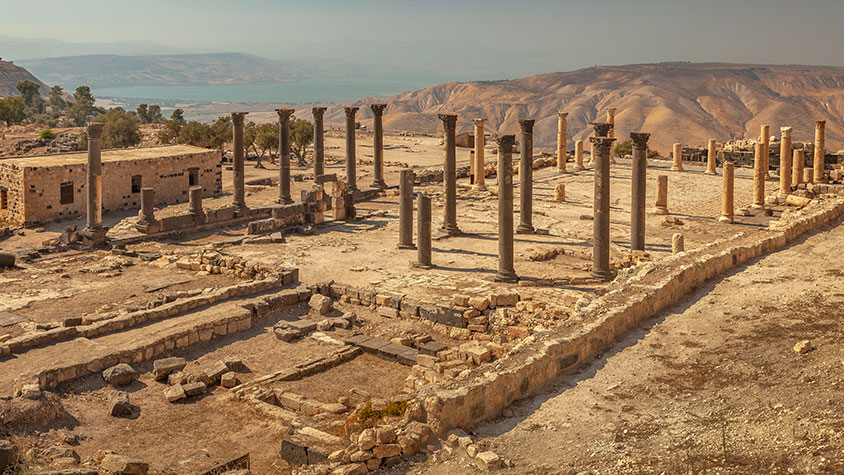For travelers wanting to visit an ancient city that offers a spectacular vista of three Middle Eastern countries: Jordan, Syria, and Israel—with a view of the Golan Heights, Mt. Hermon and the Sea of Galilee “thrown in” for inspiration, then a visit to Umm Qais in Jordan is a must. Formerly known as Gadara (taken from a Hebrew word meaning “boundary”), Umm Qais is the alleged site of the deliverance of the tomb-wandering Gadarene demoniac from whom Jesus cast out more than a few evil spirits—"rerouting them” to a nearby herd of pigs (Matthew 8:28–34).
Once a bustling center of commerce and culture during the Hellenistic and Roman periods, Umm Qais was also known as a Decapolis city—one of the regions from which Jesus drew his multitude of disciples. These early adherents to Christianity were attracted in large part to Christ’s performing of miracles, including the paradigm-shifting deliverance of the demoniac.
Today, the Jordanian region of Umm Qais that has seen many empires come and go, is divided into three main areas: the archaeological site (Gadara), the traditional village (Umm Qais), and the modern town of Umm Qais. Located in the archaeological section, are, among other architectural marvels, the colonnaded remains of a 6th-century church, the Roman Mausoleum, the Christian Crypt, and the white-marbled Five-Aisled Basilica. During the Byzantine period, the basilica was the main “mega-church” in Gadara. Several bishops, rulers and other prominent figures were buried in magnificent tombs that are still visible today.
Perhaps the most impressive of the ancient archaeological sites in Gadara, religious or otherwise, are the ancient Roman ruins, most notable of which is the Black Basalt Theater. A theater made entirely of basalt that could seat up to 3,000 people, it is among the largest of ancient Roman civilization’s entertainment venues, serving as the center for both plays and political gatherings.
Like most such venues, the theater had the “cheap seats” along with a row of elaborately carved seats for the upper-class citizens of Rome. It’s even possible that before his road-to-Damascus conversion, the privileged Roman citizen known as Saul was ushered into one of those upper-class seats. Afterwards, as the apostle Paul, it’s possible that he could have even preached there. It’s easy to imagine almost anything happening when roaming the older-than-dirt streets of Umm Qais.
One thing visitors to the region don’t have to try to imagine but can experience firsthand, are observing endangered animals such as the mountain gazelle, the ibex and the Arabian oryx. These fortunate survivors are all contented residents of Shaumari Wildlife Reserve—a destination spot incorporated in “Wild Jordan” (The Royal Society for the Conservation of Nature) that along with the Yarmouk Forest Reserve, overlooks the river Yarmouk, the largest tributary of the Jordan River. And when looking at ancient ruins all day gets a little old, Wild Jordan also offers camping, hiking and canoeing excursions for restless pilgrims.
Umm Qais is an ancient town with modern sensibilities. Where else can visitors gaze upon still-standing Ottoman-era stone houses (that remained occupied up until the 1980s), then head on over to the modern section of town where there are restaurants offering sophisticated culinary fare, cooking classes and even eco-tours with a local beekeeper? These all serve as reminders that biblical history and ancient ruins notwithstanding, pilgrims and other travelers to Umm Qais can still enjoy the accoutrements of the 21st century.
Stand in the spot where centuries-old ruins come alive, relive a biblical miracle and view three Middle Eastern countries from a hill dotted with olive trees. Visit the ancient city of Umm Qais!
Email Cindy at cindy@israeladvantagetours.com and
or
visit www.israeladvantagetours.com to make your trip of a lifetime a reality!















